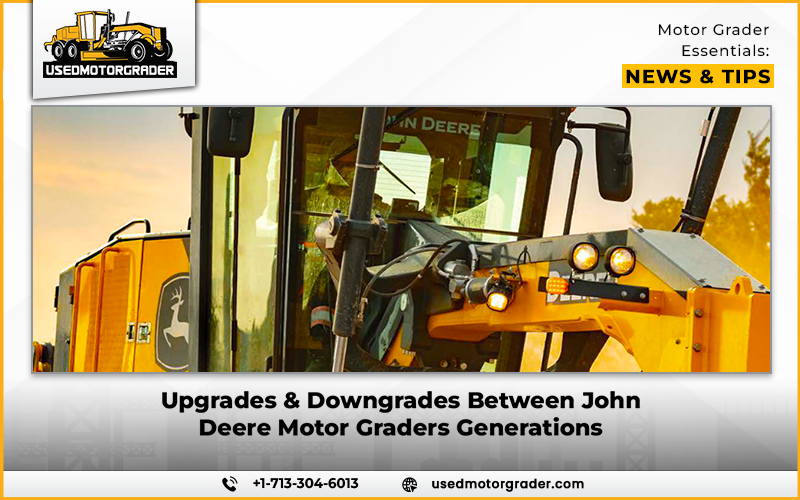Model Year Cliff Notes: (e.g., 772CH → 672G → 672GP → 772GP)
Why Model Year Differences Matter More Than Ever
When contractors approach the market to buy used John Deere motor graders, it is natural to think that the difference between a model year is incremental, say, a couple of additional buttons in the cab or a slightly different emissions system. However, in real life, the difference between a 772CH and a 672G or entry into the 772GP is not a cosmetic or comfort change; it is a step change in the way the machine is operated, serviced, and delivers ROI. As prices on used equipment remain firm and budgets become even more constrained, knowing about those generation gaps is a smart play, not merely an option.
From 772CH to G-Series: The Beginning of a Smarter Machine
The John Deere 772CH was a reliable, largely mechanical period. It had classical lever-style controls, a simple Tier 2 emissions package, and very little onboard electronics. Maintenance was mostly practical and field-ready. However, the introduction of the G-Series was a turning point. John Deere brought in electrohydraulic controls, better visibility, and cab comfort with the 672G. The control of the power was more accurate, and the transition to fuel economy was evident. This generation combined performance and new technology, providing a bit more polish without losing their wrench-friendly heritage of earlier models.
672G vs. 672GP: Grade Pro Enters the Scene
The jump from 672G to 672GP wasn’t just about a few extra features, it was a directional shift in how graders were operated. The GP in 672GP stands for “Grade Pro,” which introduced joystick controls and integrated grade control readiness as standard. For operators, this meant a more intuitive feel, less fatigue, and improved precision in finish grading applications. The GP series also featured auto-pass and return-to-straight functionality, which shaved time off repetitive cycles. Contractors working on high-spec paving or subgrade jobs found a machine that could do more with less input, though some still preferred the tactile feel of conventional controls found in the non-GP G-Series.
The Leap to 772GP: Bigger Power, Broader Capability
The 772GP took everything the 672GP offered and turned up the muscle. With a longer moldboard reach, higher horsepower, and a heavier frame, this model was clearly built for high-demand environments, snow removal, heavy earthmoving, and slope work all benefited from its broader range. The articulation joint was strengthened, drawbar durability increased, and cooling packages improved. It also retained the Grade Pro joystick layout, but on a platform with more brute force. Importantly, the 772GP became a sweet spot for contractors who needed power without giving up the finesse of electronically controlled movement.
Technology Layers: Diagnostics, Telematics, and Grade Control Evolution
Technology has quietly reshaped John Deere motor graders over the last two decades, with each generation layering on more diagnostic sophistication and connectivity. The earlier G-Series offered basic machine alerts and some rudimentary telematics, but starting with late-model G and GP units, JDLink became standard. This gave fleet managers real-time visibility into fuel burn, idle time, machine health, and GPS location. Manufacturers evolved integrated grade control in parallel, moving from compatibility with bolt-on 2D systems to fully integrated 3D solutions that dealers could activate.
For contractors bidding on fine-grading contracts or managing dispersed fleets, these tech additions changed the operating equation in a big way.
Serviceability and Parts Availability: What Older Units Still Do Best
There’s no question that older graders like the 772CH still shine when it comes to field service. Without complex sensors or computer-controlled modules, mechanics can diagnose issues quickly and make fixes with standard tools. Parts availability for these models remains strong due to their long production runs and simplicity. On the flip side, newer G-Series and GP models introduced emissions components. DEF systems and DPF filters that require more specialized service knowledge and diagnostic tools. For some buyers, that’s a manageable tradeoff for better fuel economy and emissions compliance. For others, it’s a reason to favor older units even at the expense of creature comforts and automation.
Cost vs. Capability: When Is It Worth Paying for a Newer Model?
It is always a matter of application when it comes to choosing between the generations. When the job is basic road work or subgrade grading with a small crew, the savings in cost of a 772CH or 672G is impossible to over-emphasize. They are dependable, strong, and simple. However, when accuracy finish grading is needed, integration with 3D GPS systems, or fatigue is an issue, the additional cost of a 672GP or 772GP can save overall costs in the project. In addition to the performance, new models are also more likely to retain resale value longer. Especially when manufacturers factory-equip them with grade control or high-tech options. The initial price might be painful, but lifecycle value compensates in the proper environment.
Final Take: Match the Generation to the Job, Not Just the Budget
Ultimately, choosing the right John Deere grader is not only about specs comparisons or working within a budget. It is a matter of matching the capabilities of the machine to the needs of your crew. Also, the nature of the projects you have booked in. Every generation, whether it be the mechanical simplicity of the CH. The transitional tech of the G-Series, or the refined precision of the GP models, has its sweet spot. Customers who will do more research on the actual meaning of those changes will make more intelligent purchases. Unexpected cost no more surprising for them. Further they will get machines that will perfectly suit their operations.


